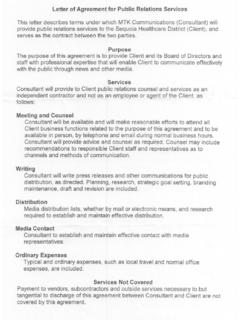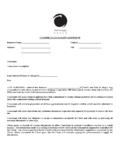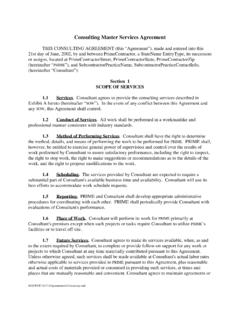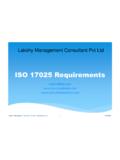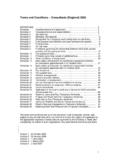Transcription of November 2004 INDEMNITIES, PART 2: …
1 I Copyright 2004. All rights , PART 2: consultant -FRIENDLY AGREEMENTSThe following material is provided for informational purposes only. Before taking any action that could have legal or otherimportant consequences, speak with a qualified professional who can provide guidance that considers your own uniquecircumstances. We would like to thank XL Insurance for their significant contribution to this agreements originated in the construction industry to hold owners harmless from liabilities that arose duringconstruction. Since the contractor has 100% control of the job site, it s only fair that the contractor should indemnify ( ,hold harmless) the owner for any site-related problems that arise.
2 Over time, however, the fairness concept behindindemnification has been corrupted. Today, architects and engineers are often forced to sign contracts that make them assume alarge portion of the owners risk even though they do not have control over those risks. Worse yet, this significant increase inliability assumed through a contractual indemnity is typically uninsurable, spelling double 1 of this two-part report examined the dangers of client-drafted indemnities, identified three types of such indemnities anddemonstrated techniques to persuade a client to abandon the use of these onerous what if a client is insistent upon including an indemnity in your contract?
3 In Part 2, we ll examine alternative forms of clientindemnities that have only limited drawbacks. We ll also address situations in which you may want to ask for a reasonableindemnity from the client, the contractor, your subconsultants and other third Mutual IndemnityThe limited-form indemnity discussed in Part I is definitely the least of the three evils examined previously. An even betteralternative, however, is a mutual indemnity that calls upon each party to indemnify the other, but only for each party s negligentacts. If a client presents you with its own indemnity language, you can counter with a mutual indemnity such as the followingexample from The Contract Guide published by XL Insurance.
4 INDEMNIFICATIONThe consultant agrees, to the fullest extent permitted by law, to indemnify and hold harmlessthe Client, its officers, directors and employees (collectively, Client) against all damages,liabilities or costs, including reasonable attorneys fees and defense costs, to the extent causedNovember 2004A LOSS PREVENTION PUBLICATION FORTHE DESIGN PROFESSIONAL Copyright 2004. All rights the Consultants negligent performance of professional services under this agreement andthat of its subconsultants or anyone for whom the consultant is legally Client agrees, to the fullest extent permitted by law, to indemnity and hold harmless theConsultant, its officers, directors, employees and subconsultants (collectively, consultant )
5 Against all damages, liabilities or costs, including reasonable attorneys fees and defense costs,to the extent caused by the Client s negligent acts in connection with the Project and the acts ofits contractors, subcontractors or consultants or anyone for whom the Client is legally the Client nor the consultant shall be obligated to indemnify the other party in anymanner whatsoever for the other party s Insurable IndemnityAs a decidedly less desirable alternative, you may consider giving an insistent client some type of unilateral indemnity that limitsthe indemnity to that which is insurable.
6 Tie the indemnity to your negligence and purge any client-generated clause of onerouslanguage. Include the concept of comparative negligence, which holds you liable for only the portion of the damages for which youare responsible (unless your state law has an even more protective provision). Finally, see that the indemnity is limited to theservices called for under the agreement . These concepts are reflected in the following sample language from XL consultant agrees, to the fullest extent permitted by law, to indemnify and hold harmlessthe Client against damages, liabilities and costs arising from the negligent acts of theConsultant in the performance of professional services under this agreement , to the extent thatthe consultant is responsible for such damages, liabilities and costs on a comparative basis offault and responsibility between the consultant and the Client.
7 The consultant shall not heobligated to indemnify the Client for the Client s own the Client Won t BudgeIf the client refuses to accept any alteration of an onerous indemnification, you have a business decision to make. You can acceptthe clause and the risk, hoping that the client will not ever have to apply the indemnity. Realize, however, that you are openingyourself up to an unlimited financial exposure that virtually no professional liability insurance policy will cover. This optionshould only be considered with a very low-risk client and project type with which your firm is thoroughly familiar and has had aclaim-free record of foolproof approach, of course, is to decline any engagement that includes an onerous indemnity provision.
8 This is a decisionthat may lose you an otherwise attractive client or project, but it may be the prudent choice to ensure your long-term who knows: your willingness to hold your ground and walk away from the work because of the indemnity clause may justearn you the client s respect and perhaps result in an eleventh hour change of heart in demanding an unfair and uninsurablecontractual You Want an Indemnity from Your ClientAs stated, the original concept of indemnity is based in fairness, and no consultant should be overly reluctant to indemnify an ownerfrom the design firm s own negligence, errors or omissions.
9 Likewise, there are certain instances where a design firm should notaccept work on a project unless the client is willing to indemnify the consultant from unusual risks. Such instances may involvehazardous waste, asbestos, condominiums, renovations or the possible unauthorized reuse of your design Copyright 2004. All rights , there are times when an indemnity from your client is the only prudent approach. Your firm did not create the hazards andyour role is to help the client overcome them. In high-risk projects, an indemnity from the owner should be a requirement for yourservices.
10 Such a contractual clause might read like the following sample from XL Insurance:INDEMNIFICATIONThe Client agrees, to the fullest extent permitted by law, to indemnify and hold harmless theConsultant, its officers, directors, employees and subconsultants (collectively, consultant )against all damages, liabilities or costs including reasonable attorneys fees and defensecosts, arising out of or in any way connected with this Project or the performance by any ofthe parties above named of the services under this agreement , excepting only thosedamages, liabilities or costs attributable to the negligent acts or negligent failure to act bythe additional protection on very risky projects, particularly those involving hazardous conditions that you can t control orproperly insure.

